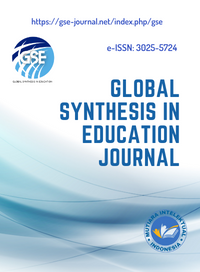Investigating Students’ Perceptions of AI-Powered Language Learning Tools in Academic Writing
DOI:
https://doi.org/10.61667/dmx3j235Keywords:
AI-powered language learning , Academic Writing, English EducationAbstract
This study examines the perceptions of English as a Foreign Language (EFL) students regarding AI-powered language learning tools for academic writing. Academic writing is crucial for Indonesian EFL students, who often struggle with grammar, vocabulary, organization, and coherence. The rise of AI tools offers a promising solution, providing personalized learning and automated feedback to enhance writing skills. Understanding student perceptions is therefore vital to assess the effectiveness and improve these tools. This research identifies the perceived benefits and drawbacks among students in the English Education Study Program at Ahmad Dahlan University. Employing a qualitative method, the study gathered data through semi-structured interviews with six fourteenth-semester students, and documentation. Using thematic data analysis, focusing on understanding the unique meanings from the participants' perspectives. Findings reveal mostly positive perceptions, with students citing ease of use, improved writing quality, and time efficiency as key benefits. AI tools offer immediate feedback, enabling students to correct errors and refine their language skills independently. However, the study also highlights the critical need for digital literacy to evaluate AI-generated suggestions, as the accuracy of feedback can vary. Concerns included potential technology dependence, AI failures in complex academic contexts, and the need for developers to improve algorithms for contextual relevance. In conclusion, AI-powered tools can significantly enhance academic writing when used thoughtfully, provided they are supported by strong digital literacy and faculty guidance, thereby maintaining human cognitive engagement. This encourages adaptive learning environments and opens avenues for future AI development research
References
Ariyanti, A., & Fitriana, R. (2017, October). EFL students' difficulties and needs in essay writing. In International Conference on Teacher Training and Education 2017 (ICTTE 2017) (pp. 32-42). Atlantis Press.
Ahmed, A., & Ahmed, M. (2022). Academic Writing: Types, Elements, and Strategies. International Journal of Language, Humanities, and Education, 5(2). https://doi.org/10.52217/ijlhe.v5i2.989
AlDakhil, M., & AlFadda, H. (2021). EFL Learners’ Perception s Regarding the Use of Busuu Application in Language Learning: Evaluating the Technology Acceptance Model (TAM). English Language Teaching, 15(1), 1. https://doi.org/10.5539/elt.v15n1p1
Alfadda, H. A., & Mahdi, H. S. (2021). Measuring Students’ Use of Zoom Application in Language Course Based on the Technology Acceptance Model (TAM). Journal of Psycholinguistic Research, 50(4), 883–900. https://doi.org/10.1007/s10936-020-09752-1
Asti, G., Yuliani, S., Marliasari, S., Tarmizi, M., Benson, K., Lawrence, M., & Wanjiku, N. (2022). English Language Translation through Students’ Opinions Toward Google Translate Machine in the EFL. Indonesian Journal of Electrical Engineering and Computer Science, 12(4), 228. https://doi.org/10.1007/s11133-019
Bandura, A. (1982). Self-efficacy mechanism in human agency. American Psychologist, 37(2), 122–147. https://doi.org/10.1037/0003-066X.37.2.122
Boy, I., & Motteram, G. (2013). Does mobile learning need to move. Global perspectives on Computer-Assisted Language Learning. Glasgow: GB, 32-35.
Chaudhary, et al. (2024). THE IMPACT OF AI-POWERED EDUCATIONAL TOOLS ON STUDENT ENGAGEMENT AND LEARNING OUTCOMES AT HIGHER EDUCATION LEVEL. International Journal of Contemporary issues in Social Sciences, 3(2). https://www.researchgate.net/publication/382559080
Choiri, M. M., & Sidiq, U. (2019). Metode Penelitian Kualitatif di Bidang Pendidikan. Natakarya.
Ermawati, N., & Delima, Z. M. (2016). PENGARUH PERSEPSI KEMUDAHAN PENGGUNAAN, PERSEPSI KEGUNAAN, dan PENGALAMAN TERHADAP MINAT WAJIB PAJAK MENGGUNAKAN SISTEM E-FILING (Studi Kasus Wajib Pajak Orang Pribadi Di Kabupaten Pati). Jurnal Akuntansi Indonesia, 5(2), 163. https://doi.org/10.30659/jai.5.2.163-174
Fahmi, M.A. & Cahyono, B.Y. (2021). EFL Students’ Perception on The Use of Grammarly and Teacher Feedback. Journal of English Education Society, 6(1). https://doi.org/10.21070/jees.v6i1.849
Faresta, R. A. (2024). AI-Powered Education: Exploring the Potential of Personalised Learning for Students’ Needs in Indonesia Education. Path of Science. 2024, 10(5). https://doi.org/10.22178/pos.104-19
Fattah, H. A., Vadivel, B., Shaban, A. A., & Shanmugam, K. (2023). Enhancing English Language Education: The Impact of AI Integration in the Classroom. Journal of Humanities and Education Development, 5(6), 116–123. https://doi.org/10.22161/jhed.5.6.15
Fitria, T. N. (2021). Grammarly as AI-powered English Writing Assistant: Students’ Alternative for Writing English. Metathesis: Journal of English Language, Literature, and Teaching, 5(1), 65. https://doi.org/10.31002/metathesis.v5i1.3519
García Botero, G., Questier, F., Cincinnato, S., He, T., & Zhu, C. (2018). Acceptance and usage of mobile assisted language learning by higher education students. Journal of Computing in Higher Education, 30(3), 426–451. https://doi.org/10.1007/s12528-018-9177-1
Ghimire, P. R., Neupane, B. P., & Dahal, N. (2024). Generative AI and AI Tools in English Language Teaching and Learning: An Exploratory Research. English Language Teaching Perspectives, 9(1–2), 30–40. https://doi.org/10.3126/eltp.v9i1-2.68716
Han, Y., Zhao, S., & Ng, L. L. (2021). How Technology Tools Impact Writing Performance, Lexical Complexity, and Perceived Self-Regulated Learning Strategies in EFL Academic Writing: A Comparative Study. Frontiers in Psychology, 12. https://doi.org/10.3389/fpsyg.2021.752793
Hockly, N. (2019). Automated writing evaluation. ELT Journal, 73(1), 82–88. https://doi.org/10.1093/elt/ccy044
Indarti, T., Fanani, U. Z., Nasrullah, R., Septiana, H., & Afdholy, N. (2024). Innovative artificial intelligence (AI) technology learning support for Indonesian language teachers at a junior high school in Tuban. Transformasi: Jurnal Pengabdian Masyarakat, 20(2), 438–452. https://doi.org/10.20414/transformasi.v20i2.11317
Johns, A. M. (1986). Coherence and Academic Writing: Some Definitions and Suggestions for Teaching. TESOL Quarterly, 20(2), 247–265. https://doi.org/10.2307/3586543
Jonassen, D. H. (1995). Computers as Cognitive Tools: Learning with Technology, Not from Technology INTRODUCTION: COMPUTERS AS COGNITIVE TOOLS. In Journal of Computing in Higher Education Spring (Vol. 6, Issue 2). https://doi.org/10.1007/BF02941038
Kristiawan, D., Bashar, K., & Pradana, D. A. (2024). Artificial Intelligence in English Language Learning: A Systematic Review of AI Tools, Applications, and Pedagogical Outcomes. The Art of Teaching English as a Foreign Language (TATEFL), 5(2), 207–218. https://doi.org/10.36663/tatefl.v5i2.912
Johnson, R. & Christensen, L. (2014). Educational Research Quantitative, Qualitative, and Mixed Approaches Fifth Edition. https://www.researchgate.net/publication/264274753_Educational_Research_Quantitative_Qualitative_and_Mixed_Approaches_Fifth_Edition
Kim, E., & Sim, J. (2024). Incorporating AI into English Language Learning: An Experimental Study Focusing on Autonomous Learning. English Language Teaching, 17(10), 82. https://doi.org/10.5539/elt.v17n10p82
Link, S., Mehrzad, M., & Rahimi, M. (2022). Impact of automated writing evaluation on teacher feedback, student revision, and writing improvement. Computer Assisted Language Learning, 35(4), 605-634.
Macinska, S., & Vinkler, A. (2024). Cambridge Papers in English Language Education the Role of AI in Language Learning: Research Evidence and Strategies for Success.
Ningsih, S., Rahayu, A. P., Suryani, N. Y., Martriwati, M., Sholikhah, M., & Khairas, E. E. (2024). Indonesian Students’ Perceptions on the Use of Artificial Intelligence (AI) in English Learning (pp. 124–132). https://doi.org/10.2991/978-2-38476-251-4_18
Patty, J. (2024). THE USE OF AI IN LANGUAGE LEARNING: WHAT YOU NEED TO KNOW. Jurnal Review Pendidikan dan Pengajaran 7(1). https://doi.org/10.31004/jrpp.v7i1.24609
Rahman, M. A. (2024). View of Exploring the Integration of Artificial Intelligence in English as a Foreign Language Education in Indonesia. Pedagogy: Journal of English Language Teaching, 12(2). 196-212. https://doi.org/10.32332/joelt.v12i2.9549
Santoso, A. (2008). Do students’ perceptions matter? A study of the effect of students’ perceptions on academic performance. 48(September 2006), pp. 209–231.
Syarifudin, A. S. (2024). CHALLENGES AND OPPORTUNITIES FOR THE APPLICATION OF AI IN LANGUAGE LEARNING IN INDONESIA. TRANSFORMATIONAL LANGUAGE, LITERATURE, AND TECHNOLOGY OVERVIEW IN LEARNING, 3(1), 49–60. https://doi.org/10.55047/transtool.v3i1.1351
Stevenson, M. (2016). A critical interpretative synthesis: The integration of automated writing evaluation into classroom writing instruction. Computers and Composition, 42, 1-16. https://doi.org/10.1016/j.compcom.2016.05.001
Thu Thuy, T. T., Mai Hoa, N. T., & Ngoc Nguyen, D. T. (2024). Cognitive Styles and Influences on Academic Writing: An Empirical Investigation among English Language Learners. English Language Teaching, 17(10), 46. https://doi.org/10.5539/elt.v17n10p46
Vadivel, B., et al. (2023). Unlocking English Proficiency: Assessing the Influence of AI-Powered Language Learning Apps on Young Learners’ Language Acquisition. International Journal of English Language, Education, and Literature Studies, 2(6), 55-62. https://doi.org/10.22161/ijeel
Waleed Daweli, T., & Abdulrahman Moqbel Mahoub, R. (2024). Exploring EFL Learners’ Perspectives on Using AI Tools and Their Impacts in Reading Instruction: An Exploratory Study. Arab World English Journal, 10, 160–171. https://doi.org/10.24093/awej/call10.11
Yuye Wang, Yuchen Jiao, Qinglin Wang; Who’s the better mentor? How AI vs human supervisor developmental feedback influences feedback acceptance. Business Process Management Journal 2025
Downloads
Published
Issue
Section
License
Copyright (c) 2025 Global Synthesis in Education Journal

This work is licensed under a Creative Commons Attribution-NonCommercial-ShareAlike 4.0 International License.




















